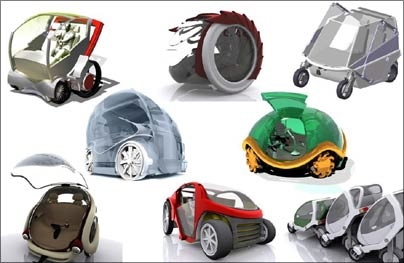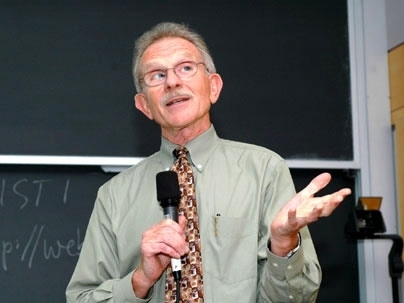The cars of the future must work more like living things and less like living rooms on wheels if we are to mitigate problems of fuel consumption and traffic congestion, according to a panel of experts who discussed "The Future of the Car -- the Car of the Future" on Sept. 22 in Room 4-237.
Three MIT engineers, two Media Lab designers and an auto industry executive participated in the panel discussion organized by the MIT International Science and Technology Initiative (MISTI) to publicize the 11-year-old international student internship program.
The talk was just one event in a weeklong series of festivities, which included foreign films, food and entertainment, a soccer tournament and a series of orientations for students interested in participating in the program, which helps students get internships in China, France, Germany, India, Italy, Japan, Mexico and Singapore.
"Car of the Future" panelists were John Heywood, the Sun Jae Professor of Mechanical Engineering and director of the Sloan Autolab; Daniel Roos, professor in the Engineering Systems Division and of civil and environmental engineering; Erica Fuchs, doctoral student in the Technology and Policy Program; William Lark and Raul-David "Retro" Poblano, graduate students in the MIT Media Lab; and Karl-Ernst Noreikat of DaimlerChrylser.
Heywood and Roos painted a grim picture of current car use, fuel economies and traffic patterns, affirming the average commuter's sense that we're all driving more and taking longer and longer to get where we're going.
"With 600 million in the U.S., cars dominate our personal transportation system. We want personal mobility. But we don't need living rooms on wheels. We need to use 200 to 300 percent less fuel, and we have to get people out of Hummers," Heywood said.
Heywood made two predictions about the future of cars in the United States: "Hydrogen vehicles will happen" and "The U.S. will never raise its fuel taxes."
He cited various strategies for shifting to more efficient cars -- improving combustion, reducing car size, reducing car weight, switching to diesel fuel, developing hybrid electric cars -- but cautioned the standing-room-only crowd not to underestimate the power of consumer car culture.
"The hybrid is the poster boy of cars of the future. Everybody thinks it will save us from our appetites. But are hybrid cars for the masses? They cost much more than other cars; they're for the high economic end, for an elite," Heywood said.
While dire in their analysis, Heywood and Roos admitted the delight of driving itself -- the "performance" aspect of car design -- was not to be dismissed. Even people who use their cars for city driving buy "high performance, zero-to-60 in seven seconds" machines.
Fuchs' research showed that the prestige of big cars and the zero-to-60 thrill exists even in markets where autos are less embedded in the culture. Chrysler, GM and DaimlerChrylser had all tried to market an "unsophisticated, low-performance, low-prestige" car in China, and they all failed, she said.
Roos explained why public transportation is not a viable alternative (too expensive and people travel too far) and described new approaches to managing road use within cities and on highways by charging tolls that vary with the time of day and level of congestion.
"In the future, systems will tie the driver and the vehicle with the roadway through intelligent transportation's variable pricing system," Roos said.
The "concept car" presentation by Lark and Poblano brightened the gray scene of present car use like Technicolor brightened Dorothy's landing in Oz.
The two Media Lab students showed slides of gum-drop-shaped cars, cars that required drivers to move like athletes, cars that adapted for storage by standing up on rear wheels and cars that could manage that all-important 90-degree pop into a parking space, thanks to hubless robotic wheels.
The Media Lab group seeks to create a car that "makes you a better citizen of your city and that does no harm," Poblano said.
Lark and Poblano showed slides and video of the group's work, including one-wheeled "cars" motoring across the Medical Center lawn and computer graphics of twin-pod cars. A sleek pair of crash test dummies drove these, leaning from side to side like bobsledders, looking surprised.
For more information about MISTI, visit mit.edu/misti/.
A version of this article appeared in MIT Tech Talk on September 28, 2005 (download PDF).








